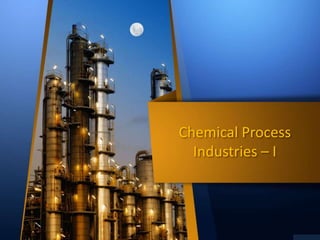
CP-I.pptx
- 2. Introduction • Course Objectives • Course contents • Reference books • Chemical Engineer • Chemical Process • Chemical Process Industry
- 3. Aim of the Course The aim of this course is to introduce chemical engineering students with the raw materials, chemical processes and equipment involved in selected chemical products.
- 4. Course Objectives • The objectives of this course are to enable students to: • Familiarize with standard symbols used for flow charts • Develop process flow diagrams using standard symbols and computer software. • Familiarize with the processes involved in selected process industries.
- 5. Course Learning Outcomes (CLOs) Upon successful completion of the course, the student should be able to: • Identify the process equipment with their standards symbols • Comprehend and develop process flow diagrams (PFDs) and piping and instrumentation diagrams (P&IDs) for various processes and products • Devise the requirements for raw materials required for manufacturing various products • Evaluate process conditions, reactions involved and interaction of different processes for common process industries..
- 6. Course Contents • Flow sheet symbols • Water conditioning and purification for industrial purposes. • Processes in Petroleum Oil Refineries. Environmental Impact of Chemical Process Industries. • Study of following chemical products with respect to their Properties, manufacturing process and major uses: 1. Glass 2. Cement 3. Sulfuric Acid 4. Nitric Acid 5. Sodium carbonate and Sodium Hydroxide. 6. Oils and Fats, 7. Soaps and Detergents 8. Paints and Varnishes 9. Sugar Industry
- 7. Recommended Books • Austin George T. (1997), “Shreve’s Chemical Process Industries” 6th Ed. McGraw-Hill International Edition. • Mark, Bhatia (2007), ”Chemical Process Industries” Vol.1, 2nd Edtion, CBS Publishers and Distributors. • Alan Heaton (1994), “The Chemical Industry” 2nd Ed. Published by Blackie Academic & Professional • Haidari Iqbal (1992), Chemical Industry in Pakistan”, Industrial Research Service Karachi. • Pandey G. N. (2000), “A Textbook of Chemical Technology” 2nd Ed. Vol-I & II Vikas Publishing House (Pvt) Limited. • Kirk Othmer (1999), Encyclopedia of Chemical Technology” Wiley Inter Science Publishers.
- 8. Chemical Engineer? A chemical engineer is a professional, who: • Has knowledge of chemical engineering, • Works principally in the chemical industry to convert basic raw materials into a variety of products, • Deals with the design and operation of plants and equipment • Develops technologies in the area of materials science, polymer engineering, and biomedical Chemical process engineer: Who applies and uses principles of chemical engineering in design, manufacture, and operation of plants and machinery in industrial chemical and related processes Chemical product engineer Who develops new or adapted substances for products ranging from fertilizer to foods, petroleum to fuels, Cosmetics to pharmaceuticals, cement to construction materials, etc.
- 9. Chemical process? A chemical process is: • determined by the atomic and molecular composition and structure of the substances involved is called a chemical Process. • occur by itself or be caused by an outside force • involves a chemical reaction
- 10. Chemical Process Industry An organization which transforms raw materials in to useful products involving “chemical change (including physio – chemical changes e.g. separation and purification” Chemical Plant: An industrial process plant that manufactures (or processes) chemicals, usually on a large scale involving a chemical or biological transformation.
- 11. Chemical Process Analysis • Material and Energy Balance • Thermodynamics • Transport phenomenon • Unit Operations • Plant Equipment • Process Flow Diagrams • Instrumentation and process control • Economics